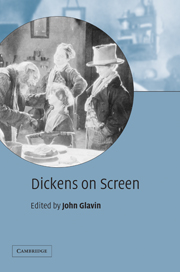Book contents
- Frontmatter
- Contents
- List of illustrations
- Notes on the contributors
- Acknowledgments
- Introduction
- Part I
- Part II
- 2 David Copperfield's home movies
- 3 David Lean's Great Expectations
- 4 Great Expectations on Australian television
- 5 Dickens's “The Signalman” and Rubini's La stazione
- 6 Bill Murray's Christmas Carols
- 7 Screen memories in Dickens and Woody Allen
- Part III
- Part IV
- Part V
- Index
3 - David Lean's Great Expectations
Published online by Cambridge University Press: 22 September 2009
- Frontmatter
- Contents
- List of illustrations
- Notes on the contributors
- Acknowledgments
- Introduction
- Part I
- Part II
- 2 David Copperfield's home movies
- 3 David Lean's Great Expectations
- 4 Great Expectations on Australian television
- 5 Dickens's “The Signalman” and Rubini's La stazione
- 6 Bill Murray's Christmas Carols
- 7 Screen memories in Dickens and Woody Allen
- Part III
- Part IV
- Part V
- Index
Summary
In his 1946 Great Expectations David Lean didn't film Dickens's novel. He remade the novel into David Lean's film. Lean completely reversed the thrust of Dickens's story. In the novel the power of the manipulative (step-)godmother is displaced by the benevolent godfather. Throughout the narrative, the male–male bonds of Magwitch–Pip, Herbert–Pip, Joe–Pip, and even Orlick–Pip structure the protagonist's moral and social development, and completely determine the book's final third. But with Lean the most interesting relationship is not among men but between women, Estella and Miss Havisham. And the final third of the film seems to evaporate into inconsequence in contrast to the power of the childhood sequences the women dominate. In contrast to the haunting and haunted child Pip (Anthony Wager), the adult Pip (John Mills) feels like a nonentity. Notoriously, the Lean ending is banal and unconvincing, a wet spot the viewer wants to avoid rolling onto once the best parts of the film are over. His now infamous “hand-in-hand toward the sunset” finish effectively swipes from beneath Dickens's novel its entire moral, ethical, and aesthetic foundation. It is the young Estella and her “aunt” who capture our imagination, and who provide the images that remain most firmly in our minds, long after the actual viewing ends.
- Type
- Chapter
- Information
- Dickens on Screen , pp. 39 - 44Publisher: Cambridge University PressPrint publication year: 2003

